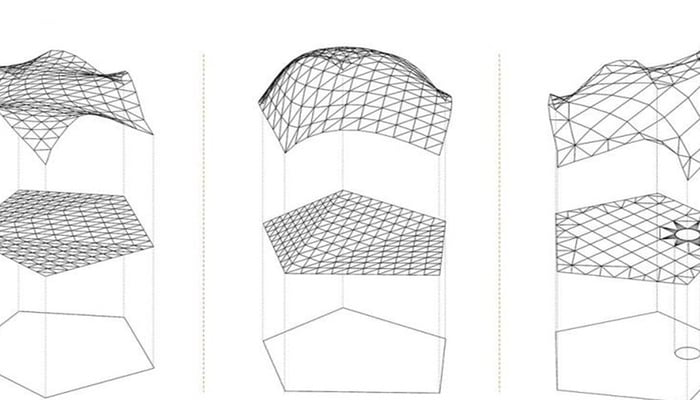8 Best Places to Learn Computational Design (2025)

Table of Contents
Computational design is the next avant-garde movement in the architecture industry. Many architects are showing interest in computational design online training courses and master’s to keep up with the fast-paced industry. Although it is still not as popular as BIM, there are already several computational design courses available to learn about various computational tools used in the AEC industry. Check out the popular online computational design courses to kickstart your new creative freedom!
What Is Computational Design?
Computational Design is a complex design technique that applies parameters and algorithms powered by computation for advanced design workflows. It merges computational capabilities and design through a logical process. The application of Computational Design allows architects to do more than just model and draw in design software. The logical sequences of workflows and the data the tools can provide enable an effective and efficient design solution.

Learning Computational Design
As one of our Computational Design Course mentors, Brice Pannetier, states, one does not need to be a computational designer to work on computational design workflows. Even architects and engineers can use it in their regular design workflows. Additionally, the realm of generative design, a facet of computational design, opens up innovative possibilities by allowing algorithms to create and optimise designs based on specified parameters.
For a career in computational design, you need an in-depth understanding, i.e. learning, of this advanced methodology. This is also where the hesitation begins. As it is quite a drastic contrast from conventional modelling and design workflows, many architects hesitate to pick up the new skill.
Those who are brave enough to take on this complexity find themselves enrolling in master’s degree programs. Masters in computational design are good options. However, they are also costly and may require moving to a new country to enrol.
The good news is that the times are changing. We now have more options at our disposal than ever before to start learning computational design. In addition to computational design masters, there are now computational design online training courses.
Read More : Computational vs Parametric vs Generative Design
Why Should You Learn Computational Design?
Knowing computational design tools feeds the futuristic landscape of parametric design that not only unleashes sustainable benefits but also expands the designer's imagination. The integration of generative design techniques further propels the evolution of parametric architecture, where algorithms play a key role in creating innovative, efficient, and sustainable designs. Here are 5 reasons why you must learn computational design:
1. Creative freedom
It has given architects unprecedented ability to explore and experiment with forms and structures. The creative freedom, when combined with analytical data, produces optimised designs that are efficient, responsive and sustainable.
2. Better efficiency with automation
Architects and engineers can be more creative and efficient with less time spent on repetitive tasks. The computational design tools will take care of all the tedious tasks with unbelievable accuracy.
3. Expansive applications
Computational design is fast becoming an essential in the AEC industry. Its application is expansive – from architecture and design to AI and machine learning.
4. Better pay and career opportunities
All the advantages of computational design skills have opened up new opportunities and better pay for architects and engineers.
5. Sought after by top firms
As the industry learns more about its benefits, major AEC and design firms are seeking out professionals skilled in computational design. You can even work at Nike as a computational designer!
List of Computational Design Courses for Architects and Engineers
In this list below, we will share noteworthy computational design master courses and computational design online courses.
Note that this list does not include any courses that focus only on parametric modelling or Rhino 3D. After all, parametric modelling, or parametric design, is just one of the verticals of computational design and does not guarantee a concrete knowledge of computational design.
1. Novatr | Master Computational Design For Real-World Application
Tuition fees - $4800 (₹3,45,000)
Duration - 10 months
Entry requirement - Open to all design and engineering students and professionals
Traditionally, learning computational design is offered through a master's program for architects who want to explore the design realm. Doing a master’s requires a big investment financially and mentally. These facts have spurred Novatr to create a computational design course for architects and engineers to master this advanced design technology at one-tenth the price of a master’s programme. The 10-month computational design course is an online course where you will learn from industry professionals from coveted AEC firms with extensive experience in computational design. This ensures an industry-relevant curriculum that focuses highly on real-world application.
The first 10 weeks focus on theory and parametric design modelling. Then the learners will progress into more advanced computational design geometries and workflows. What makes Novatr’s course unique is that it offers 2 specialisations – High-Performance Building Analysis and Computational BIM. The learners are free to choose their specialisation before starting the live capstone project.
Once the programme is over, the learners can still expect a great deal – more specifically, job placement support. 80% of the eligible candidates from the first BIM cohort have been placed at some of the most coveted MNCs in the AEC industry with an average pay hike of 60%. Learners from the computational design course can expect the same, if not better, pay hikes and job opportunities, all assisted by the programme.
2. CMU School Of Architecture | Master Of Advanced Architectural Design (MAAD)
Tuition fees - $41,000 (2023-2024 Academic Year - Fall and Spring semesters)
Duration - 2 years (4 semesters)
Entry requirement - An architecture degree (any of the following - B.A, B.Sc, B.Arch and M.Arch).
The Master of Advanced Architectural Design (MAAD) by Carnegie Mellon University is the studio-based postgraduate programme that explores emerging methods of design and construction. Through technologies, the programme also speculates upon architectural practice, material culture, and enhanced construction methods in the built environment.
In four semesters, the students will explore and probe the intrinsic interweaving of sustainability, design methodologies and construction processes through technical and cultural opportunities.
Read More : What Does a Computational Designer Do and How to Become One
3. CMU School of Architecture | Master Of Science In Computational Design
Tuition fees - $38,990 (2021-2022 Academic Year - Fall and Spring semesters)
Duration - 2 years
Entry requirement - open to applicants from architecture, engineering, media arts, and computer science backgrounds
The Master of Science in Computational Design (MSCD) explores the intersection between design and computation to investigate new design opportunities and critical perspectives. As such, it is a research-based programme to explore technical and cultural aspects of computation in relation to architecture and the built environment.
Students under the MSCD course will work closely with other students from the School of Architecture programmes. As a research programme, the students will work at the Design Fabrication Laboratory (dFAB) and Applied Architectural Robotics Laboratory.
4. Columbia | Master Of Science In Computational Design Practices
Tuition fees - $31,290 per term for 12-19 credit points
Duration - 3 semesters (Spring, Summer and Fall)
Entry requirements - an undergraduate degree from an accredited college or university
Columbia University’s M.S.CDP is a fairly new course launched in 2021. It integrates computational design practices for architecture, data visualisation, and urban planning at multiple scales.
The students will study in three colloquium courses, one each semester, and will prepare an independent research project for the final Design in Action colloquium. To provide students with core competencies before the course, foundation courses in computational design methods are available for architecture and urban planning.
Read More : Famous Architecture Firms Making Use of Computational Design
5. UCL Bartlett | Architectural Computation MSc/MRes
Tuition fees - M.Sc - £32,100 (international students), £16,100 (UK students)
M.Res - £26,200 (international students), £14,100 (UK students)
Duration - 1 year
Entry requirements - a second-class degree from a UK university or an overseas equivalent + basic computing experience
The Bartlett school of architecture of UCL is a globally renowned architectural school. The M.Sc or M.Res in Architectural Computation focuses on computation and advanced digital design to tackle how tomorrow’s built environment will be designed and built.
M.Sc in Architectural Computation is awarded when 180 credits are completed in 1 year. There is also an option to get a PG Dip in Architectural Computation with the achievement of 120 credits. The M.Res programmes meanwhile focuses on research skills with a self-directed route for those interested in pursuing a doctoral degree.
6. Architectural Association | Emergent Technologies MSc/MArch
Tuition fees - M.Sc - £27,972; M.Arch - £38,835
Duration - M.Sc - 12 months; M.Arch - 16 months
Entry requirements - M.Sc - Graduates of architecture and engineering
M.Arch - Graduates of architecture
The architectural association offers the Emergent Technologies programmes as both M.Sc and M.Arch courses. The post-professional course aims to investigate the synergies between architecture and ecology using computational design and advanced fabrication. The research-driven design projects encourage critical thinking through experience.
Design research is the core of this computational design master’s programme. The course structure consists of the Studio, which both M.Sc and M.Arch students will undertake together, and the Dissertation.
Read More : Explore Top 5 Computational Design Jobs & Salaries for Architects
7. IAAC | Master In Advanced Computation For Architecture & Design
Tuition fees - €9,900
Duration - 10 months (online; synchronous and asynchronous)
Entry requirement - a bachelor’s degree in related field
The computational design master’s degree by IAAC (Institute of Advanced Architecture of Catalonia) is an unique course in that it is offered as an online programme in either synchronous or asynchronous format. It offers a theoretical and practical knowledge of computational design through the applications of design simulation, analysis and optimization of digital data in architecture.
In the course of 10 months, the students will study 3 modules on environmental and structural design, BIM and smart construction, and Artificial Intelligence in Architecture. The Master thesis project ends the curriculum for this online computational design (architecture) masters. Each module can also be studied independently.
8. Design Morphine | Master Of Science In Computational And Advanced Design
Tuition fees - €11700
Duration - 9 months
Entry requirement - a degree in architecture or other related design fields
DesignMorphine is an accredited online educational institution that offers the sole degree in computational design master’s. The online M.Sc programme breaks down the curriculum into 5 Technical and Theoretical Labs. The course begins with the basics into generation which later progresses to more complex architectural projects.
As an online course, the students will get to explore and learn a variety of software to visualise their concepts. The 9-month degree is accredited by the University of Architecture, Civil Engineering, and Geodesy from Sofia, Bulgaria.
Read More : Top 7 Computational Design Courses for Architects
Conclusion
Learning such an advanced design methodology like computational design has never been easier. Although there are still few cohort-based computational design online courses, we can observe an increase in the interest through the growing number of master’s programmes in this niche. But courses such as that of Novatr is proof that you don’t need to do a master’s degree to become an expert in computational design.
Unlock your creativity with Novatr and master Computational Design for real-world application. Head to our Resources to find out why computational design is the craze now and why you need to learn it.

 Thanks for connecting!
Thanks for connecting!





.png)


.jpg)





